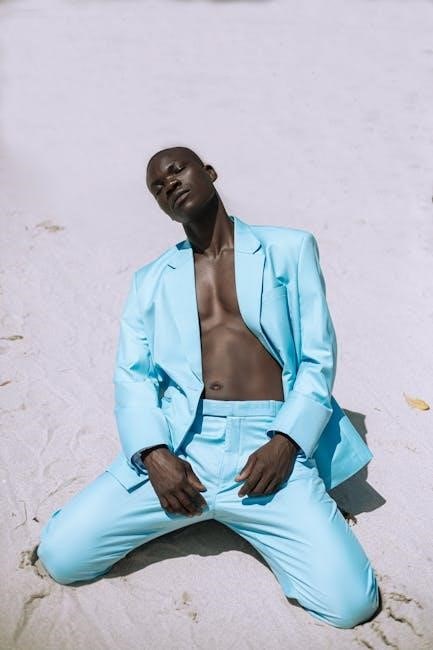
Importance of Proper Fit in Blazers
A well-fitted blazer enhances confidence, style, and comfort, making it a wardrobe staple․ Proper fit ensures a polished look, while poor fit can ruin the overall aesthetic․

Understanding Blazer Measurements
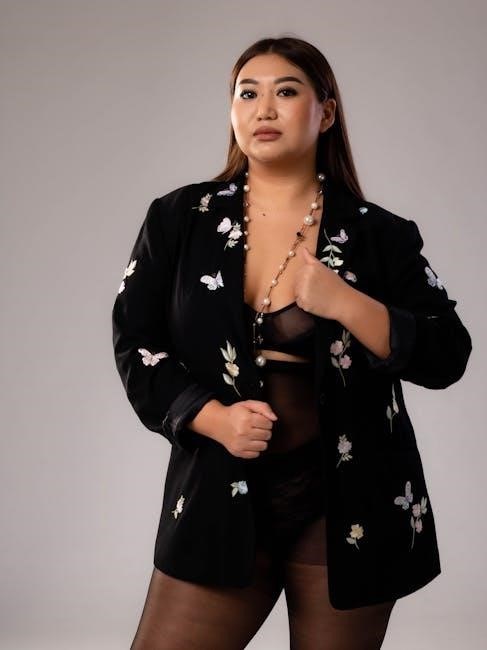
Accurate measurements are key to a perfect fit․ Chest, shoulders, sleeves, and body length must align with your body proportions for a tailored, polished appearance․
2․1․ Chest Measurement
The chest measurement is crucial for determining the right blazer size․ It is measured around the widest part of your chest, keeping the tape measure level and parallel to the floor․ Ensure the tape isn’t too tight or too loose, as this can lead to an inaccurate size․ If your measurement falls between two sizes, it’s often recommended to opt for the larger size to ensure comfort and a proper fit․ The chest measurement directly impacts how the blazer sits on your body, ensuring it isn’t too restrictive or overly loose․ Accurate chest measurement is essential for maintaining both style and functionality, as it affects the overall drape and structure of the blazer․ Proper fit ensures freedom of movement while maintaining a polished, tailored appearance․
2․2․ Shoulder Measurement
The shoulder measurement is a critical factor in achieving a well-fitted blazer․ It is measured from the base of the neck, across the top of the shoulder, to the tip of the other shoulder․ Ensuring the tape measure is level and follows the natural curve of your body is essential for accuracy․ The shoulder measurement determines how the blazer sits on your frame, impacting both comfort and aesthetics․ A blazer with shoulders that are too narrow may feel restrictive, while overly broad shoulders can look unflattering․ Proper shoulder fit ensures the blazer drapes cleanly, maintaining a balanced and polished appearance․ This measurement is vital for creating a tailored look that complements your body structure and enhances your overall style․
2․3․ Sleeve Length Measurement
Sleeve length is a crucial measurement for a well-fitted blazer․ It is measured from the center back of the neck, over the shoulder, and down to the desired cuff length․ Proper sleeve length ensures the blazer fits proportionally to your body; The sleeves should reach just past the wrist bone, allowing shirt cuffs to peek out slightly․ Incorrect sleeve length can disrupt the overall balance of the blazer․ Too short, and the jacket may look ill-fitting; too long, and it can overwhelm your frame․ Ensuring accurate sleeve length is essential for both comfort and style, as it impacts the ease of movement and the streamlined appearance of the garment․ This measurement plays a key role in achieving a polished and professional look in your blazer․
2․4․ Body Length Measurement

Body length measurement is essential for ensuring the blazer fits appropriately and flatters your silhouette․ It is typically measured from the base of the neck, down the spine, to the desired hemline․ The ideal length should cover the hips or reach just below the waist, depending on the style․ A well-proportioned body length ensures the jacket neither appears too boxy nor overly cropped․ Proper fit avoids the jacket looking too tight or overly loose, maintaining a streamlined appearance․ Accurate body length measurement is vital for comfort and aesthetics, as it impacts how the blazer drapes on the body and aligns with other features like sleeve length and shoulders․ This ensures a balanced and polished look, making it a critical factor in achieving the perfect fit․
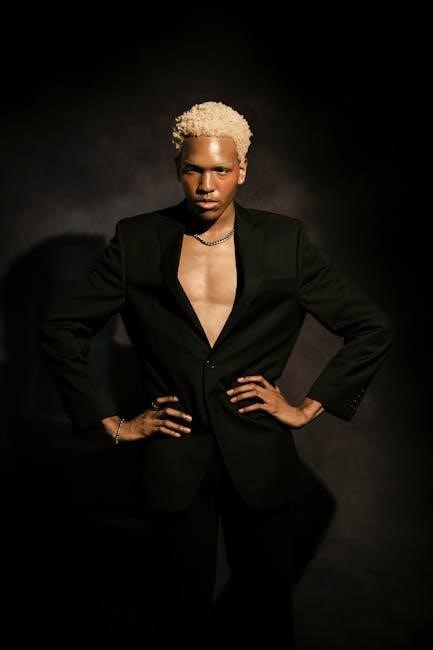
Types of Blazers and Their Fit
Blazers come in various styles, each offering a unique fit․ Single-breasted, double-breasted, and unstructured blazers cater to different body types and preferences, ensuring a tailored look for every individual․
3․1․ Single-Breasted Blazers
A single-breasted blazer is the most common style, featuring a single row of buttons․ It typically has two or three buttons, creating a streamlined look․ This style is versatile and suits most body types, making it ideal for both formal and semi-formal occasions․ The fit should be snug but not restrictive, with the blazer skimming the body naturally․ The shoulders should align perfectly with the body’s shoulders, while the sleeves should end just above the wrist bone․ The length should hit slightly below the hip for a balanced proportions․ Single-breasted blazers are popular for their classic appeal and ease of styling․ They can be paired with trousers, skirts, or even jeans for a polished look․ Ensuring the right fit is key to pulling off this timeless piece effectively, as it enhances both professionalism and personal style․
3․2․ Double-Breasted Blazers
A double-breasted blazer features two rows of buttons, creating a broader, more structured silhouette․ This style is ideal for those seeking a bold, sophisticated look․ The double-breasted design can add width to the torso, making it flattering for slimmer builds or those looking to balance proportions․ The fit should be slightly roomier than single-breasted blazers, with the top buttons fastened to create a defined chest area․ The shoulders should still align with the body’s natural shoulders, and the sleeves should end just above the wrist․ The length of a double-breasted blazer is often slightly longer, hitting mid-thigh for a balanced proportion․ This style is perfect for formal events or business meetings, offering a polished and authoritative appearance․ Proper fit is crucial to avoid bulkiness, ensuring the blazer drapes smoothly across the chest and torso․
3․3․ Unstructured Blazers
An unstructured blazer is a more relaxed, casual alternative to traditional blazers, typically lacking padding in the shoulders and chest․ This style offers a softer, more natural drape, making it ideal for casual or semi-formal occasions․ The fit should still be tailored but not overly tight, with the chest area fitting snugly but allowing ease of movement․ The shoulders should align with the body’s natural shoulders, avoiding any slipping or sagging․ Sleeve length should end just above the wrist, maintaining proportion with the overall design․ The body length is slightly shorter, hitting at the hips, which creates a streamlined, modern silhouette․ Unstructured blazers are perfect for warmer weather or casual settings, offering versatility while maintaining a polished appearance․ Proper fit ensures the blazer looks intentional, even in its more relaxed form․
How to Choose the Right Size
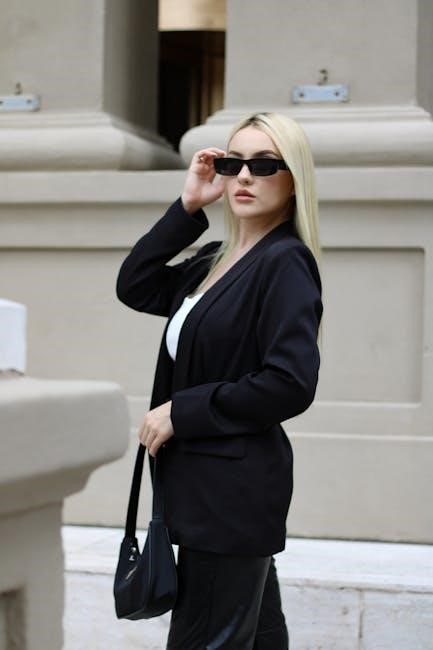
Use a size chart, measure yourself accurately, and consider fabric thickness to ensure the best fit for your blazer, balancing comfort and style effortlessly․
4․1․ Using a Size Chart
Using a size chart is essential for ensuring the best fit when selecting a blazer․ These charts provide a guide to correlate body measurements with corresponding sizes․ They typically include measurements for chest, shoulders, sleeve length, and body length, helping you identify the most suitable size․ Always double-check your measurements to ensure accuracy, as sizing can vary between brands․ Consider the fabric thickness and style, as these factors can affect how the blazer fits․ Consider consulting the size chart specific to the brand or retailer, as sizing standards may differ․ By referencing a size chart, you can make informed decisions and avoid common sizing mistakes, ensuring a tailored and polished look․ This step is crucial for achieving comfort and style in your blazer choice․
4․2․ Measuring Yourself
Measuring yourself accurately is crucial for selecting the right blazer size․ Start by gathering a flexible tape measure and standing in front of a mirror․ Measure your chest by wrapping the tape around the widest part of your torso, keeping it level and parallel to the floor․ Next, measure your shoulders by placing the tape across the back, from one shoulder tip to the other․ Sleeve length is measured from the center back of your neck, over your shoulder, and down to your wrist․ Finally, measure your body length from the base of the neck down to your hipbone․ Take these measurements while wearing a thin shirt or similar fabric to ensure accuracy․ Cross-referencing these measurements with a size chart will help you find your ideal fit․ For the best results, consider having someone assist you for precise readings․
4․3․ Considering Fabric and Style
When choosing a blazer, fabric and style play a significant role in achieving the perfect fit․ Different fabrics, such as wool, cotton, or linen, drape differently and affect how the blazer sits on your body․ A structured fabric like wool provides a crisp, tailored look, while unstructured fabrics like linen offer a more relaxed fit․ Additionally, the style of the blazer, such as single-breasted, double-breasted, or unstructured, impacts how it fits․ For example, a double-breasted blazer may require a slightly longer torso for balance, while a slim-fit style demands precise measurements․ Consider your body type and personal comfort when selecting a fabric and style․ Pairing the right fabric with the appropriate style ensures both comfort and a flattering silhouette․ Always cross-reference your measurements with the fabric and style to make an informed choice․

Common Mistakes to Avoid
A proper fit is crucial for style and comfort․ Common mistakes include ignoring shoulder fit, incorrect sleeve length, and poor fabric choice, which can ruin the overall appearance and comfort․ Addressing these issues ensures a polished and flattering look․
5․1․ Ignoring Shoulder Fit
Shoulder fit is a critical aspect of a blazer’s overall appearance․ Ill-fitting shoulders can make the blazer look too big or too small, throwing off the entire silhouette․ If the shoulder pads slip off your shoulders or dig into them, it disrupts the jacket’s balance․ Proper shoulder fit ensures the blazer hangs smoothly, creating a polished and professional look․ Many people overlook this detail, but it significantly impacts the garment’s structure and comfort․ To avoid this mistake, ensure the shoulder pads align perfectly with your natural shoulder line and the fabric lies flat without bunching or stretching․ Addressing shoulder fit is essential for achieving a tailored, flattering appearance that enhances your confidence and style․
5․2․ Overlooking Sleeve Length
Sleeve length is a crucial detail often overlooked when selecting a blazer․ Properly fitted sleeves should end just past the wrist, allowing a slight portion of the shirt cuff to be visible․ If the sleeves are too long, they can make the arms appear shorter and the torso longer, creating an unbalanced silhouette․ Conversely, sleeves that are too short may give the impression of an ill-fitting jacket․ Ignoring sleeve length can result in a blazer that looks awkward and uncomfortable․ To ensure a polished look, always check that the sleeves align with your natural arm length and allow for a small portion of your shirt cuff to show․ This attention to detail enhances both comfort and style, making the blazer look tailored to perfection․
5․3․ Not Considering Body Type
Ignoring your body type when choosing a blazer can lead to an unflattering fit․ Petite individuals should opt for shorter jackets to avoid overwhelming their frame, while taller people may benefit from longer styles to balance proportions․ Hourglass figures can accentuate their curves with fitted blazers, whereas rectangular body types may prefer structured designs to add shape․ Broad-shouldered individuals should avoid overly padded shoulders to maintain balance․ Failing to consider body type can result in a blazer that either swamps or restricts the body, creating an unpolished look․ Tailoring is key to ensuring the blazer complements your physique, regardless of body type․ Always prioritize styles that enhance your natural shape for a confident, put-together appearance․

Alterations and Adjustments
Professional tailoring can refine a blazer’s fit, ensuring shoulders, sleeves, and hem align perfectly․ DIY tweaks, like button adjustments, can also enhance comfort and style without full tailoring․
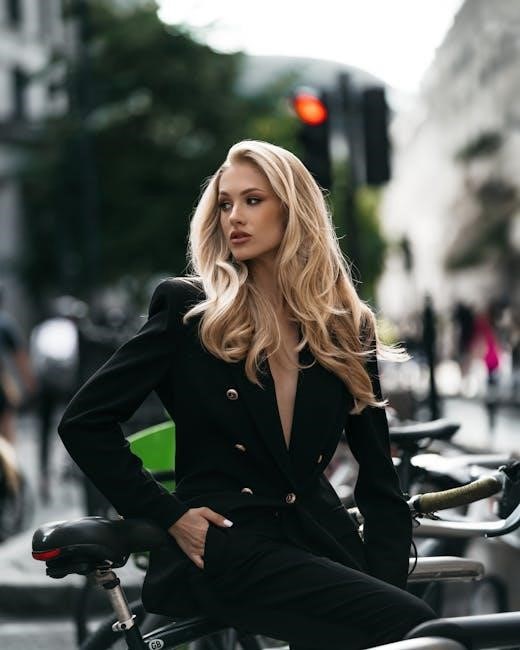
6․1․ Tailoring Options
Tailoring is a crucial step in achieving the perfect blazer fit․ Common adjustments include shoulder padding, sleeve length alterations, and hemming to ensure the jacket sits flawlessly on the body․ A professional tailor can also taper the torso for a more streamlined appearance or adjust button placement for optimal symmetry․ Additionally, taking in or letting out seams can address fit issues caused by fabric stretch or sizing discrepancies․ When visiting a tailor, it’s essential to provide clear measurements and preferences to ensure the final result meets your expectations․ Tailoring not only enhances the aesthetic appeal of the blazer but also improves comfort and confidence․ By addressing specific areas, you can transform an ill-fitting blazer into a bespoke piece tailored to your unique proportions․
6․2․ DIY Adjustments
DIY adjustments can be a cost-effective way to refine your blazer fit without professional tailoring․ Simple tweaks like shortening sleeves, hemming the bottom, or adjusting button placement can make a significant difference․ For minor alterations, such as tightening or loosening seams, you can use basic sewing tools like a needle, thread, and scissors․ Additionally, darts or fabric pins can help create a more tailored silhouette․ Online tutorials can guide you through these processes, ensuring you achieve the desired results․ However, more complex changes, like restructuring shoulders or reworking zippers, may require professional expertise․ DIY adjustments are ideal for small modifications, allowing you to personalize your blazer while staying within budget and enhancing its overall fit․

Final Tips for the Perfect Fit
Securing the perfect fit in a blazer is a combination of careful measurement, style awareness, and attention to detail․ Always try on a blazer before purchasing, if possible, to ensure comfort and proportions․ Use size charts as a guide, but remember that sizing can vary between brands․ Consider the fabric—stretchy materials offer flexibility, while structured fabrics provide a crisp look․ Tailoring is a worthwhile investment for a bespoke fit, but minor adjustments can often be made at home․ Confidence and posture complete the look, so choose a blazer that makes you feel polished and put-together․ By prioritizing fit, fabric, and style, you’ll create a timeless, sophisticated wardrobe staple․